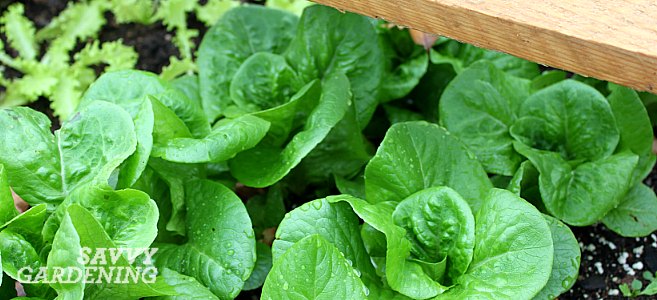This post may contain affiliate links. If you make a purchase through links on our site, we may earn a commission.
In my first book, The Year Round Vegetable Gardener, I detailed the many ways I use cold frames to extend my homegrown harvest into winter. However, a cold frame is also an easy way to get a jump start on spring, planting weeks – even months – earlier than in traditional vegetable gardens.
Spring cold frame tips:
- Clean! On a mild day, spring clean your cold frame tops! Whether glass or plastic, the sashes can eventually get grimy and giving them a quick wipe down will allow more light to reach your plants. More light = healthier plants and faster growth.
- Vent! Whenever the temperature climbs above 4 C (40 F), I crack open my cold frames to prevent heat build-up. Crops that are grown too warm will have soft foliage and be prone to damage if the mercury suddenly drops. I keep it simple and use a piece of scrap wood to prop open the tops. On mild rainy spring days, let Mother Nature water your crops by opening the cold frame completely.
- Sow! It’s best to direct seed veggies into your cold frames. Transplanting seedlings that were started indoors usually results in disappointment as those tender plants aren’t tough enough for the temperature fluctuations found in a spring cold frame. However, you can use your frames as a seeding bed to start crops like broccoli, kale, and cabbage, eventually moving them to the open garden when the spring weather is more settled.
- Feed! Once your early cold frame crops are done, pull up any debris and amend the soil with compost or aged manure. I often give the soil a boost by growing green manure crops in my frames – an easy – and cheap – way to improve the soil.
Related post: Sign up for the Savvy Gardening newsletter!

Related post: Cold frames = winter veggies
Spring cold frame crops:
- Greens! All of the cool and cold season salad greens can be planted in an early spring cold frame. Common crops like lettuce, spinach, and arugula, as well as lesser known ones like mizuna, mibuna, and broccoli raab.
- Roots! My favourite roots for cold frames include baby beets, Japanese turnips, radishes, and carrots.
- Onions! Scallions are one of the easiest crops to grow in a cold frame. My go-to scallion is Evergreen Hardy White, which is reliable and very cold tolerant. Or, try baby onions like Purplette! Ready just 2 months from seeding.
What do you have growing in your spring cold frames?




I was inspired by this post and the warm day so I just planted 5 kinds of lettuce and some Tom Thumb peas in my cold frame. I am craving salad!
Thank you Elaine!! I’m so excited about my Tom Thumb peas.. I just sowed some in a few small pots and also my frames. C’mon spring! 🙂 – Niki
I have an unheated porch with a south-facing window that currently houses a parsley plant that has grown all winter long. Can I seed greens in a seed tray and transplant into pots while keeping them on a shelf in that south-facing porch window throughout the spring in an attempt to mimic a cold frame, and will the plants grow? Located in Cape Breton.
Hi Niki, I live in New Brunswick and started with a hoop tunnel this year over a raised bed. The bed was completely thawed and the temp. reading for the soil is 0 degrees Celsius and I planted the seeds for lettuce, spinach, carrots, & chard..I do not see any signs of them coming through the soil yet and I was just wondering if it takes a little longer for them to germinate because the ground isn’t warm yet? Do you normally take a reading of the soil temperature before planting in the spring under the hoop tunnel/cold frame? Thanks
Hi Lori-Lynn, Great question! Yes, it will definitely take them longer to germinate because of the cool soil temp. They should be up shortly and just make sure you keep the soil evenly moist. It’s amazing how quickly it can dry out – even when it’s cold out – because of the protection of the tunnel. I don’t usually bother taking a reading of the soil temp.. I rely on the finger test! 🙂 Once the soil has thawed, I’m ready to plant in my frames and mini tunnels. Good luck and keep us posted! – Niki
Great article! I’ll be building another cold frame this fall for root crops; I hadn’t thought of plating those “under cover.” I also use a cold frame as an “emergency” safe place to hold trays of warm-weather plants overnight when a frost is expected during hardening off before transplanting outdoors.